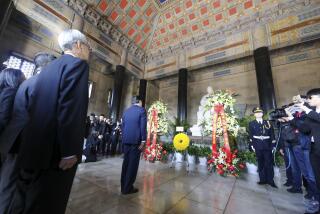Rare Visit to Mao’s Home Reflects His Love of Books, Ping-Pong
- Share via
BEIJING — The former imperial compound where the late Chairman Mao Tse-tung lived for nearly two decades is today a slightly shabby place where selected Chinese tourists are presented an image of a man who loved books and table tennis.
Built with gray bricks, gray roof tiles and vermilion columns in the traditional Chinese style around a 60-foot-by- 80-foot tree-shaded courtyard, the 325-year-old residence now has something of the lifeless aura of a poorly maintained ancient history museum.
Usually closed to foreigners--and also to Chinese except those on tours arranged through their workplaces--Mao’s old home and an adjacent park-like area were visited Saturday by about 200 foreign journalists accredited to cover the 13th National Congress of China’s Communist Party.
Told that they would be touring Zhongnanhai--a part of the former Qing Dynasty palace that is now the residential and work compound of China’s top leaders--nearly all participants expected to be taken past buildings now in use as homes or offices. But those areas remained off-limits.
Instead, the reporters found themselves mixing with several thousand Chinese sightseers, walking through parts of the compound that were the center of power for the first 17 years after the 1949 founding of the People’s Republic of China.
In 1966, when Mao launched the 10-year-long Cultural Revolution, he moved to a different building inside Zhongnanhai, and meetings of the top leadership were also shifted. Guides Saturday would not say why Mao moved.
A large painting displayed in the courtyard of Mao’s old home gives an idyllic image of the late chairman and four other top leaders gathered in chairs under the courtyard trees. A sign says that these five men--Mao, Chen Yun, the late president Liu Shao-chi, the late Premier Chou En-lai and the late military leader Chu Teh--often held meetings here on summer evenings during the 1950s.
The focus of the home tour, which included only part of the residence, was Mao’s bedroom. Glass-fronted bookshelves were filled with texts. Arranged across half of Mao’s double bed were about two dozen books and magazines, ranging from “Modern Chinese History” to old issues of the English-language Beijing Review.
“The point is that he liked books,” a guide explained.
Sheets of plastic lie over the bed, lamps and other furniture, easing the task of upkeep for the current staff but detracting from the quality of the display.
In a room along another side of the courtyard is a green Ping-Pong table, paddles and ball ready for use but with the net sagging severely. A picture of Mao, paddle in hand, is on the wall.
Less than half a mile away, in the Great Hall of the People, delegates to the party congress have spent the past week approving a new socialist theory that stresses economic development above all else, thus fundamentally repudiating much of Mao’s ideology, which emphasized class struggle and revolutionary fervor.
All of this has left ordinary Chinese visitors to the Great Helmsman’s old home a bit uncertain about how to speak of him.
Asked how Mao’s apparent mistakes during the Cultural Revolution should be assessed, one of the tourists, Chen Bingyuan, from the eastern Chinese city of Hangzhou, replied nervously that “our leaders are now probing into this.”
“It’s very hard for us to probe into it ourselves,” he said. “We don’t really understand it yet. We’re trying to understand.”
But anyway, Chen added, Mao “was still the chairman of our party until the end of his life.”
“People admire and respect him and are interested in visiting the place where he lived,” Chen said. “I never imagined he had so many studies filled with books. And other things--that he loved Ping-Pong.
“Zhongnanhai wasn’t open before. Now it’s open, so people can understand. I can see that until the end of his life Chairman Mao continued to study. You see, look at all the books on his bed.”
More to Read
Sign up for Essential California
The most important California stories and recommendations in your inbox every morning.
You may occasionally receive promotional content from the Los Angeles Times.













